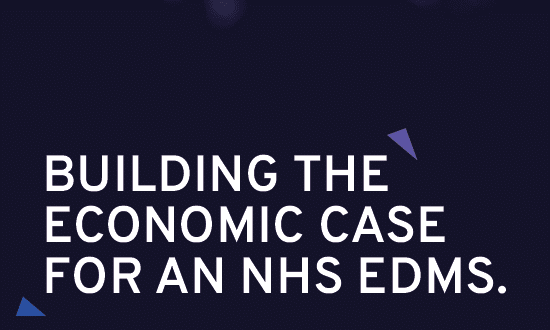Nottingham to review digital care record due to patient safety concerns
- 5 October 2017

Nottingham University Hospitals NHS Trust is to urgently review its £14m digital records system after dozens of consultants wrote to the trust medical director expressing concerns about the system and its impact on patient safety.
Consultants at the trust have raised patient safety concerns around the difficulty of accessing electronic patient records and some records missing key data, including information on appointments.
The trust medical director said that the digital clinical records software did not meet the needs of consultants. The problems were discussed by the trust board in September which is now reviewing monthly.
Dr Keith Girling, trust medical director, said the introduction of the DHR system had caused “much more disruption to patients, clinicians and services” than anticipated.
Nottingham, the third biggest trust in the country, is working on a best of breed digital health records programme, begun two years ago, that includes a major scanning and document management project, involving spending £5.8m on scanning 57 million documents, plus £5.9m was spent on the deployment of the DHR and £2.7m on hardware and software.
Dr Girling said in a statement: “Some features are an improvement on paper records, including instant access to records for urgent and emergency care, but there are several impactful weaknesses which are causing consultant colleagues very significant inconvenience and frustration.”
A trust spokesperson told Digital Health News the concerns centred on the trust’s Fortrus document management system.
Dr Girling said the records software does not meet the needs of consultants: “It is clear that the current product does not meet the needs of consultants and is adding to the time and complexity of patient reviews.”
He added: “Some features are an improvement on paper records, including instant access to records for urgent and emergency care, but there are several impactful weaknesses which are causing consultant colleagues very significant inconvenience and frustration.
A trust spokesperson told Digital Health News that the review had been triggered after a group of consultants wrote to Dr Girling expressing their frustrations with the system. “Staff said that they wanted records scanned in rather than entering data directly, but there is some real unhappiness with how the system is working.”
The trust statement said: “Related ICT products that work alongside this system are mitigating patient safety risks. Monthly updates on DHR and progress will be received by the trust’s quality assurance committee from October.”
Dr Girling said the trust will seek feedback from clinicians when redesigning the system.
“We will be acting on this feedback to ensure that, with our suppliers, we can design a system that better meets clinical need and improves care and safety for our patients.”
The spokesperson told Digital health that problems had been bubbling away for a number of months.





15 Comments
My understanding is that the “supplier” in this case is the Trust itself, as this is a locally developed best of breed solution.
See https://www.computerworlduk.com/it-management/nottingham-university-hospitals-cio-plans-for-paperless-records-3574396/
That article scares me a little – 354 systems! How did it get that bad?
I think they need to read some of your work on IHE XDS, helped me when implementing similar solutions. Thanks
I guess that depends on how you define a “system” 🙂
The NHS has a habit of describing MS Access databases as systems and they can grow like weeds if not kept under control – an IG nightmare when they contain PID. Even without including databases, it is amazing how systems can proliferate, especially when Trusts are merged and each has a full set of different, often incompatible, systems.
Sadly I’m not the Dave renowned for IHE XDS guidance, I think that was Dave Harvey 🙂
Perhaps some Electronic Document Management approaches miss the opportunity to be the foundation of workflows that are granular and flexible enough to be patient-focused. That is a difficult goal. Just automating paper flow definitely isn’t enough by itself for quality, safety, or even productivity improvement. Going paper-less means leaving the paper-based paradigm. Especially when its not just the technology but the organisational change management that needs sufficient and continued investment.
[Full disclosure: I work for an EPR Supplier, but these are my personal views.]
Mike
This EPR/ EDM debate is all wrong: we need both. The legacy paper and any new day forward paper needs to be digitised to cut the high cost of managing this. If a piece of paper is created today (most Trusts even with EPR create 100,000 – 300,000 pages per week) we have to keep this for at least 8 years and who is to say we can just “junk” it and use an EPR. By digitising current records we set the scene for EPR AND save about 0.5% of a trusts turnover £1.5m – £3m per annum in space, pay and consumables. If an EPR alone was ever going to rid us of paper we would know that by now as we have been trying for 25 years to my knowledge. The legal profession, accountants, insurers, finance and investment, central govt. have ALL digitised legacy content, but (largely) not the NHS as yet. If the whole of the acute sector in England did it, this would save £300m per annum, releasing 10,000 WTE posts and 200,000 sq m in space. Btw I don’t work for EPR or EDM vendors…
I would agree with the previous commentators – scanning strategy is the key here. How you index and separate documents to present a meaningful chronology to a clinician is the challenge.
To save money at the scanning phase, many EDMS Trusts have just scanned an entire section of legacy notes (such as ‘Medicine’) as one document. These can be 100s of pages long for some patients.
This then means that clinicians have to expend much time searching or (more likely) give up using the system. To make EDMSs useable, much more effort is needed upfront to separate at the document level and classify document types. Tagging each individual document by date written allows much better chronological viewing for the clinician. And categorisation of document types within a section of notes allows filtering by document type.
For Day forward scanning, this can be addressed by having “written on” date in a standard place on each piece of paper where it can be subject to character recognition and application of a barcode or a unique code for each document type. This makes the day-forward scanning task able to be partially automated.
But many Trusts today don’t even know what types of document exist on paper, so auditing notes and finding that out is a good starting point before you embark on any procurement.
And to address the point made at the top of the comments thread, this is not a UX issue, but it is about usability. Most people who’ve seen it would say that the UX of the Fortrus products is very impressive. Usability in an EDMS is about more than just UX, it’s about how you segregate, capture, date and tag clinical content in order to make it quickly findable at point of care.
Two minds on this. I strongly suspect this fault was detected and fixed at another trust.
It was not a fault with the fortrus product itself but the ‘enterprise’ technology around it and trust requirements which mostly came from the ‘to be’ legacy dept. Informatics fixed it, once they got involved. Should the supplier have done better in preventing the issues? Probably.
Reading between the lines here, a supplier has put a system in and some clinicians don’t like it. What % of clinicians? Tell me a system that has ever had 100% support across board? What risks? What mitigations? Was this worse before the system? Without knowing all the facts which this article doesn’t give, some of the comments here are somewhat focused on one perception.
When we looked at the electronic document management market we found it dominated by companies offering “bespoke” solutions to what is really a standard solution. The Gartner magic quadrant was filled with solutions for global companies. We ended up going with Al Fresco because it was open source and pitched more at what a hospital Trust needs not what they are offered.
This isn’t a product placement but definitely is about cavat emptor – buyer beware.
I have to agree with Geoff around the procurement process and costs for the project – it seems that the suppliers have seen the Trust coming!
It does make you wonder what sort of process was undertaken initially to award a contract of such value when the Trust are now stating “We will be acting on this feedback to ensure that, with our suppliers, we can design a system that better meets clinical need and improves care and safety for our patients”. Where was the clinical engagement at the outset of the project??!
The primary focus of such a project is 100% ALWAYS on delivering the desired clinical and patient benefits, which is why clinical engagement (at the outset) is fundamental to a project of this nature.
If only you experts could be put to use in the service we wold have no problems
This is helps explain the importance of functionality within the EDMS system – the need to be able to index and find information once scanned. This needs to be considered at procurement stage (along with the contractual and scanning criteria which Geoff mentions).
Yes but its not a Space X project to do this well, surely all the learning from the national programme and before should have prevented this.
The cost seems way over what a good procurement process would deliver AND why is the Trust paying if the delivery is so poor, the contract they have and gateway controls should have protected them…
Great comment.
Of course you realise that the NHS operates in silos and so shared learning is rare. Local collaboration doesn’t happen because of “competition” and more generally there are barriers to sharing further afield.
The NHS operates in silos at great expense to the tax payer and patients who suffer as a result. Only the other day Leeds we’re being trumpeted for a 3 year pilot. This stuff has already done! We need a concerted effort on adopting proven technology at scale.
Not only are patients suffering while we are dilly dallying but technology moves at such a pace we can’t afford to have a cycle that is 3 year pilot followed by scale and extend. That’s the best part of a decade gone.
You also hit on another important point. Procurement. We all know this is something of a shambles in the NHS, again with not much going on centrally. Many of the contracts I have seen don’t have clear exit clauses or plans that would allow a graceful exit from a contract which came to a natural end never-mind a failing contract.
When these conversations come up I can well imagine in most cases it is the same story, too risky to exit and so the comfortable option is to throw more money in to the solution and struggle through.
Like you say this isn’t rocket science and even if it was we’ve landed on comment millions of miles away.
Sounds like this thing is being designed at arms length by their suppliers. This either a UX failure, or poor implementation. Both are very common in this industry…
Comments are closed.